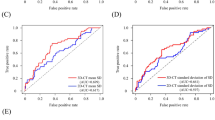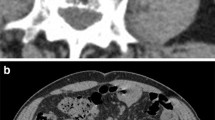Abstract
Computed tomography (CT) attenuation value of ureteral stones is one of the predictors of shockwave lithotripsy (SWL) outcome. It is common to use the mean Hounsfield units (HU) to describe the CT attenuation value. However, an observer bias can occur when measuring the mean HU in the conventional method. On the other hand, our way to obtain only the maximum HU is simpler and less biased. We retrospectively evaluated 464 patients with ureteral stones who underwent SWL and compared predictive accuracy of various factors including maximum and mean HU. Results were determined after a single SWL. Predictors of SWL success were examined by the statistical analysis of successful and failed groups. 324 of the 464 patients who underwent SWL were stone-free after a single SWL. Significant differences were found in factors related to CT attenuation value and stone size. As a result of receiver operating characteristic analysis, it was found that maximum HU and mean HU, major diameter and volume have equivalent prediction accuracy, respectively. Multivariate analysis revealed that maximum HU and major diameter were included in independent predictors. We also examined the new original indicators using maximum HU and major diameter. Stone-resistant probability obtained from the logistic model and Maximum HU and Major diameter Index obtained by multiplying maximum HU by major diameter were useful for predicting SWL success, respectively. In conclusion, maximum HU and mean HU have equivalent predictive accuracy, and maximum HU is easier to measure and less biased than mean HU.



Similar content being viewed by others
References
Tran TY, McGillen K, Cone EB, Pareek G (2015) Triple D score is a reportable predictor of shockwave lithotripsy stone-free rates. J Endourol 29:226–230
Perks AE, Schuler TD, Lee J et al (2008) Stone attenuation and skin-to-stone distance on computer tomography predicts for stone fragmentation by shock wave lithotripsy. Urology 72(4):765–769
Badran YA, Abdelaziz AS, Shehab MA et al (2016) Is scoring system of computed tomography based metric parameters can accurately predicts shock wave lithotripsy stone-free rates and aid in the development of treatment strategies? Urol Ann 8:197–202
Niwa N, Matsumoto K, Miyahara M et al (2017) Simple and practical nomograms for predicting the stone-free rate after shock wave lithotripsy in patients with a solitary upper ureteral stone. World J Urol 35(9):1455–1461
Massoud AM, Abdelbary AM, Al-Dessoukey AA et al (2014) The success of extracorporeal shock-wave lithotripsy based on the stone-attenuation value from non-contrast computed tomography. AJU 12:155–161
Yazici O, Tuncer M, Sahin C et al (2015) Shock wave lithotripsy in ureteral stones: evaluation of patient and stone related predictive factors. Int Braz J Urol 41(4):676–682
Lee JY, Kim JH, Kang DH et al (2016) Stone heterogeneity index as the standard deviation of Hounsfield units. A novel predictor for shock-wave lithotripsy outcomes in ureter calculi. Sci Rep. 6:23988. https://doi.org/10.1038/srep23988
Yamashita S, Kohjimoto Y, Iguchi T et al (2017) Variation coefficient of stone density: a novel predictor of extracorporeal shockwave lithotripsy. J Endourol 31(4):384–390
Tanaka M, Yokota E, Toyonaga Y et al (2013) Stone attenuation value and cross-sectional area on computed tomography predict the success of shock wave lithotripsy. KJU 54:454–459
Mullhaupt G, Engeler DS, Schmid HP, Abt D (2015) How do stone attenuation and skin-to-stone distance in computed tomography influence the performance of shock wave lithotripsy in ureteral stone disease? BMC Urol 15:72
Ouzaid I, Al-qahtani S, Dominique S et al (2012) A 970 Hounsfield units (HU) threshold of kidney stone density on non-contrast computed tomography (NCCT) improves patients’ selection for extracorporeal shockwave lithotripsy (ESWL): evidence from a prospective study. BJU Int 110:E438–E442
Niewada EB, Dybowski B, Radziszewski P (2014) Predicting stone composition before treatment -can it really drive clinical decisions? Cent Euro J Urol 67(4):392–396
Khalifa BB, Naouar S, Gazzah W, Salem B, Kamel RE (2016) Predictive factors of extracorporeal shock wave lithotripsy success for urinary stones. Latunisie Medicale 94:397–400
Geng JH, Tu HP, Shih PMC et al (2015) Noncontrast computed tomography can predict the outcome of shockwave lithotripsy via accurate stone measurement and abdominal fat distribuition determination. KJMS 31:34–41
Bandi G, Meiners RJ, Pickhardt PJ et al (2008) Stone measurement by volumetric three-dimensional computed tomography for predicting the outcome after extracorporeal shock wave lithotripsy. BJU Int 103:524–528
Gupta NP, Ansari MS, Kesarvani P, Kapoor A, Mukhopadhyay S (2005) Role of computed tomography with no contrast medium enhancement in predicting the outcome of extracorporeal shock wave lithotripsy for urinary calculi. BJU Int 95:1285–1288
Kuroda S, Ito H, Sakamaki K et al (2018) A new prediction model for operative time of flexible ureteroscopy with lithotripsy for the treatment of renal stones. PLoS One 13(2):e0192597
Baron RL, Rohmann CA, Lee SP, Shuman WP, Teefey SA (1988) CT evaluation of gallstones in vitro. Correlation with chemical analysis. AJR 151:1123–1128
Acknowledgements
The authors would like to thank Dr. Tomomi Yamada and appreciate her support for the statistical analyses of this study.
Author information
Authors and Affiliations
Corresponding author
Ethics declarations
Conflict of interest
All authors declare that they have no conflict of interest.
Ethical approval
All procedures performed in studies involving human participants were in accordance with the ethical standards of the institutional and/or national research committee and with the 1964 Helsinki Declaration and its later amendments or comparable ethical standards.
Additional information
Publisher’s Note
Springer Nature remains neutral with regard to jurisdictional claims in published maps and institutional affiliations.
Rights and permissions
About this article
Cite this article
Sugino, Y., Kato, T., Furuya, S. et al. The usefulness of the maximum Hounsfield units (HU) in predicting the shockwave lithotripsy outcome for ureteral stones and the proposal of novel indicators using the maximum HU. Urolithiasis 48, 85–91 (2020). https://doi.org/10.1007/s00240-019-01123-3
Received:
Accepted:
Published:
Issue Date:
DOI: https://doi.org/10.1007/s00240-019-01123-3




